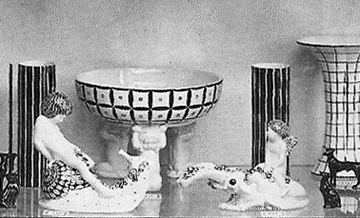Product Description
Michael Powolny / Wiener Werkstaette Vienna Secession “Schneckenreiter” c. 1910


MICHAEL POWOLNY (1871-1954) Austria
BERTOLD LÖFFLER (1874-1960) Austria
VEREINIGTE WIENER UND GMUNDNER KERAMIK Vienna
Schneckenreiter c. 1910
Glazed white earthenware hand-painted with black enamel
Marks: conjoined WK (in a square), KG with flower (in a square), 81 (impressed)
***Extremely rare Powolny model in black and white.
Model illustrated: Michael Powolny: Keramik und Glas aus Wien 1900 bis 1950, Elisabeth Frottier (Vienna: Böhlau Verlag, 1990), p. 50, illus. 20, cat. no. WV43; Vienna 1900, Vienna, Scotland and the European Avant-Garde, Peter Vergo (Edinburgh, Scotland, 1983), p. 63, plate 19; “Austrian Architecture and Decoration,” The Studio Year Book of Decorative Art 1911 (London: The Studio, 1911), p. 233.
This model may also be found in the permanent collection of the Victoria & Albert Museum, London (Inventory number 604, 1966).
H: 7″ x W: 7 3/4″ x D: 4″
Price: $10,500
Michael Powolny / Wiener Werkstaette Vienna Secession “Schneckenreiter” c. 1910
Michael Powolny (1871-1954) Austria.
Bertold Löffler (1874-1960) Austria.
Vereinigte Wiener Und Gmundner Keramik.
Pedestal centerpiece bowl, circa 1906.
Hand-painted faience with a black and white diamond pattern on three pedestal legs on a black base with an edge of repeat white triangles and all supporting a black bowl with a white interior.
Marked: Conjoined WK (in a square), KG (with flower cipher in square), 43 (incised under glaze) / 3,1P (painted).
Another example of this same model can be found in the National Gallery of Victoria in Melbourne, Australia.
Illustrated: Wiener Werkstätte Period Photo Archiv, MAK Museum, Vienna, p. 42.Vienna 1900-1930: Art in the Home, Historical Design, Inc., exhib. cat. (New York: 1996) p. 45; Viennese Design and the Wiener Werkstätte, J. Kallir (New York: Galerie St. Etienne, 1986), p. 80; Wiener Keramik, Historismus, Jugendstil, Art Déco, Waltraud Neuwirth (Braunschweig: Klinkhardt & Biermann, 1974), p. 349.
H: 8 1/2″ x Dia: 9 7/8″
Price: $10,500
